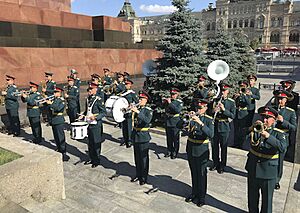Lenin's Mausoleum facts for kids
| Мавзолей Ленина Mavzoley Lenina |
|
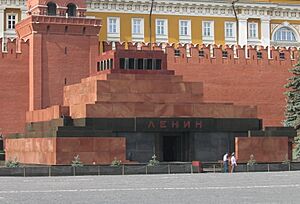
Lenin's Mausoleum, 2006
|
|
| Coordinates | 55°45′13″N 37°37′11″E / 55.75361°N 37.61972°E |
|---|---|
| Location | Moscow, Russia |
| Designer | Alexey Shchusev |
| Type | Memorial |
| Material | Concrete and marble |
| Completion date | 10 November 1930 |
| Dedicated to | Vladimir Lenin Joseph Stalin (formerly) |
Lenin's Mausoleum, also called Lenin's Tomb, is a famous building in Moscow, Russia. It is located in Red Square. This building is the resting place of Vladimir Lenin, a former leader of the Soviet Union.
Lenin's preserved body has been on public display since shortly after his death in 1924. There have been only a few times when it was not shown, mostly during wartime. The top of the mausoleum has a special platform. Soviet leaders used this platform to watch military parades. The building was designed by Alexey Shchusev. It has features inspired by ancient tombs, like the Pyramid of Djoser and the Tomb of Cyrus the Great.
Contents
A Look Back: History of Lenin's Mausoleum
After Vladimir Lenin died on January 21, 1924, architect Alexey Shchusev was asked to design a place for his body. People wanted to view Lenin's body. A wooden tomb was quickly built in Red Square, near the Moscow Kremlin Wall. It was ready by January 27, 1924. Lenin's coffin was placed inside on that day.
Over 100,000 Soviet citizens visited the tomb in the next six weeks. By the end of May, Shchusev replaced the first tomb with a larger, more detailed wooden mausoleum. Lenin's body was then moved into a special sarcophagus designed by Konstantin Melnikov. This new wooden mausoleum opened to the public on August 1, 1924.
-
-
- Preserving Lenin's Body: Early Efforts===
-
A doctor named Alexei Ivanovich Abrikosov first embalmed Lenin's body after his death. Later, Boris Zbarsky and Vladimir Vorobiev were given the job of keeping it preserved. Zbarsky's son, Ilya Zbarsky, who had just finished Moscow University, helped his father. He compared their work to that of ancient Egyptian priests who made mummies.
In 1925, Boris Zbarsky and Vorobiev told the Soviet government that the wooden building needed to be replaced. They found mold growing on the walls and even on Lenin's body. So, a new mausoleum was built. It was made of marble, porphyry, granite, and labradorite. Shchusev designed this new stone building, which was finished in 1930.
The mausoleum also became a special viewing stand. Soviet leaders stood there to watch military parades in Red Square.
-
-
- Changes Over Time: War and Removals===
-
Lenin's body has been on display almost all the time since the stone mausoleum was finished in 1930. In October 1941, during World War II, Moscow seemed like it might be captured. So, Lenin's body was moved to Tyumen in Siberia for safety. After the war, the body was brought back, and the tomb reopened.
From 1953 to 1961, the preserved body of Joseph Stalin was also displayed next to Lenin's. However, Stalin's body was later removed. This happened as part of a process called de-Stalinization and Khrushchev's Thaw. Stalin's body was then buried in the Kremlin Wall Necropolis. In 1973, a new sarcophagus for Lenin's body was designed by sculptor Nikolai Tomsky.
On January 26, 1924, a special guard was placed at the mausoleum. This guard was known as the "Number One Sentry." This guard of honor was removed after the Russian constitutional crisis of 1993. However, it was brought back four years later at the Tomb of the Unknown Soldier in Alexander Garden.
Building the Mausoleum: Design and Features
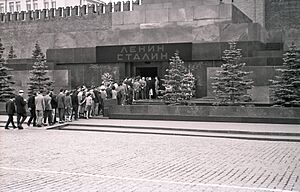
In January 1925, a competition was held to design a stone tomb for Lenin's body. Many ideas were submitted, including a ship, a globe, an Egyptian pyramid, and a five-pointed star. But the committee decided to keep a design similar to the earlier wooden mausoleum.
Alexey Shchusev created new drawings. His plan, which used red granite, black and grey labradorite, was approved. The heavy base under the sarcophagus weighed twenty tons. It was placed on a thick layer of sand. Special poles were driven around it to protect the tomb from vibrations.
About 2900 square meters of polished granite were used for the building. The top slab of red Karelian Shoksha quartzite rests on granite columns. These different types of granite were brought from all over the USSR.
The stone mausoleum was finished in October 1930. It took sixteen months to build. The new building was three meters taller than the wooden one. Its total weight was about 10,000 tons. The mausoleum became the highest point in Red Square.
During construction, the mausoleum and the nearby burial ground were given a similar look. Old tombstones were removed. Individual and group burials near the Nikolskaya and Spasskaya Towers were combined. New guest stands for ten thousand people were built on both sides of the mausoleum.
-
-
- Inside the Mausoleum: A Quiet Journey===
-
The mausoleum has an entrance area, a Mourning Hall, and two staircases. Opposite the entrance is a large granite block with the State Emblem of the Soviet Union on it.
Visitors go down two staircases from the entrance. The left staircase, three meters wide, leads to the Funeral Hall. The walls of this path are made of grey labradorite. The Funeral Hall is a ten-meter cube with a stepped ceiling. A band of black labradorite runs across the room. Red porphyry pillars are placed on this band. Next to the pillars are bright red smalt bands, with black labradorite bands to their right. This design makes it look like flames and banners are waving. In the center of the hall is a black stand with Lenin's sarcophagus.
The top part of the sarcophagus seems to float in the air. It is held up by four hidden metal columns. The bottom part is covered in reddish jasper. The sarcophagus itself is made of two slanted glass cones held together by a bronze frame. Lights and light filters are built into the top of the frame. They give the body a soft pink color and reduce heat. On both sides of the sarcophagus are bronze banners, which look shiny because of the special lighting. At the head of the sarcophagus is the Soviet State Emblem, surrounded by oak and laurel branches. At the foot, there are branches wrapped with a ribbon.
After viewing, visitors exit the Funeral Hall using the right-hand staircase, which leads back to Red Square.
Preserving Lenin's Body: Science and Care
One big challenge for the people preserving Lenin's body was dark spots. These spots appeared especially on his face and hands. They solved this problem using different chemicals. For example, if wrinkles or discoloration appeared, they treated it with a mix of acetic acid and ethyl alcohol diluted with water. Hydrogen peroxide could be used to bring back the original color of the tissues. Damp spots were removed using disinfectants like quinine or phenol.
Every year, Lenin's body is soaked in a solution of glycerol and potassium acetate. Fake eyeballs were placed in his eye sockets to keep them from collapsing.
Until the collapse of the Soviet Union in 1991, the Soviet government paid for this preservation work. After 1991, the government stopped funding it. Then, private donations paid for the mausoleum's upkeep. In 2016, the Russian government decided to pay again. They announced they would spend 13 million rubles to preserve Lenin's body.
Lenin's Mausoleum Today: Visiting and Changes
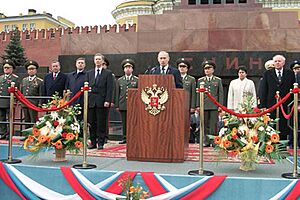
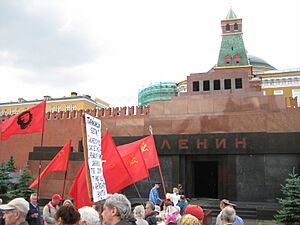
Lenin's Mausoleum is open to the public on Tuesdays, Wednesdays, Thursdays, Saturdays, and Sundays. It is open from 10:00 AM to 1:00 PM. Visitors still line up to see Lenin's body, though the lines are not as long as they used to be. There is no charge to enter.
Before entering, visitors are checked by armed police or military guards. Inside the tomb, visitors must show respect. Taking photos or videos is not allowed. Talking, smoking, keeping hands in pockets, or wearing hats (unless you are female) are also forbidden.
Lenin's Mausoleum has changed its look since the Soviet Union ended. One of the first changes was adding gates to the staircases leading to the platform on top. This was done to stop people from using the platform without permission after the guard was removed.
Starting in 2012, the mausoleum's foundation was repaired. This was needed because a building attached to the mausoleum in 1983 caused problems. That building had an escalator that Politburo members used to go up to the platform. The escalator was removed after the platform was no longer used. After these repairs, the mausoleum reopened on April 30, 2013. It was ready for the May 1st holiday, "The Day of Spring and Labour."
Discussions: Should Lenin Be Buried?
Since 1991, there has been talk about moving Lenin's body. Some suggest burying him in the Kremlin Wall Necropolis. Russian President Boris Yeltsin wanted to close the mausoleum. He thought Lenin should be buried next to his mother, Maria Alexandrovna Ulyanova, in St. Petersburg.
However, Yeltsin's successor, Vladimir Putin, disagreed. Putin said that burying Lenin would make many older citizens feel that their lives and beliefs during the Soviet era were wrong.
On July 24, 2001, Vladimir Putin explained his view:
Our country lived under the power of the CPSU for 70 years. This is a whole generation's lifetime. Many people connect their lives with Lenin's name. For them, burying Lenin would mean they believed in false things. It would mean their lives were lived for nothing. I think such actions could lead to the kind of destructive state we have already seen.
In 2009, Vladimir Medinsky, a politician from United Russia, said there was no reason to keep Lenin's body in the mausoleum. He felt it was wrong to keep an "ideological artifact" in the capital's center. He also thought it was a waste of money and unfair to Lenin's family and those who did not agree with communist ideas.
On April 20, 2017, some politicians suggested a law about burying historical figures. They believed Lenin's body should be buried, but they didn't set a specific date. The idea was to allow burials when the public was ready. However, after discussion and criticism, the politicians withdrew their support for the bill. The government also did not support it.
In 2018, RIA Novosti reported that Vladimir Petrov, a politician from Leningrad Oblast, suggested creating a special group to look into removing Lenin's body. Petrov even thought about replacing the body with a copy made of fake material.
In November 2018, Sergey Malinkovich from the Communists of Russia party called for Petrov to be charged with a crime. He said Petrov's idea insulted religious believers and caused hatred. He planned to keep pushing for charges against Petrov.
Honors and Recognition
- The Hungarian People's Republic released a postage stamp showing the mausoleum on February 20, 1952.
- The Soviet Union issued postage stamps featuring the mausoleum in 1925, 1934, 1944, 1946, 1947, 1948, and 1949.
See also
- Kumsusan Palace of the Sun
- Ho Chi Minh Mausoleum
- Kremlin Wall Necropolis
- Tampere Lenin Museum
- Chairman Mao Memorial Hall
- Pyramid of Tirana
- House of Flowers
- Sun Yat-sen Mausoleum
- Che Guevara Mausoleum
- Santa Ifigenia Cemetery
- Sükhbaatar's Mausoleum
- Georgi Dimitrov Mausoleum
- National Monument in Vitkov
- Mustafa Kemal Atatürk's Mausoleum
- Mausoleum of Ruhollah Khomeini
- Raj Ghat
- Mazar-e-Quaid
- Bourguiba mausoleum
- Türkmenbaşy Ruhy Mosque
- Artigas Mausoleum
- Martyrs' Mausoleum, Yangon
- Mausoleum of Arafat
- Leninism
- Marxism–Leninism






